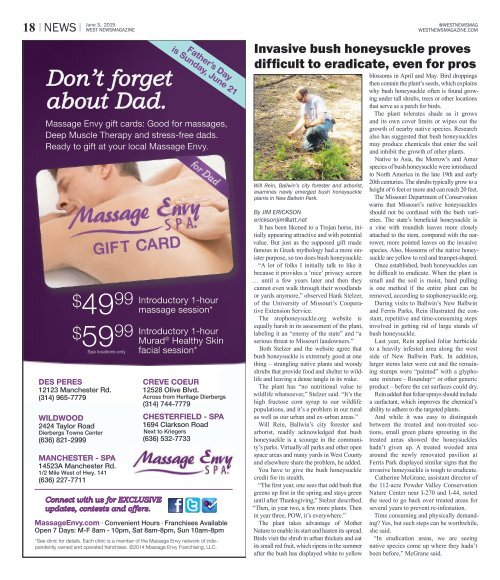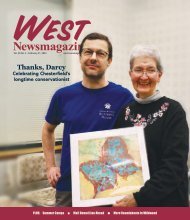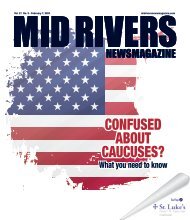West Newsmagazine 6/3/15
news, politics, st. louis county
news, politics, st. louis county
Create successful ePaper yourself
Turn your PDF publications into a flip-book with our unique Google optimized e-Paper software.
18 I NEWS I<br />
June 3, 20<strong>15</strong><br />
WEST NEWSMAGAZINE<br />
Don’t forget<br />
about Dad.<br />
Massage Envy gift cards: Good for massages,<br />
Deep Muscle Therapy and stress-free dads.<br />
Ready to gift at your local Massage Envy.<br />
$49 99<br />
$59 99<br />
DES PERES<br />
12123 Manchester Rd.<br />
(314) 965-7779<br />
WILDWOOD<br />
2424 Taylor Road<br />
Dierbergs Towne Center<br />
(636) 821-2999<br />
Spa locations only<br />
MANCHESTER - SPA<br />
14523A Manchester Rd.<br />
1/2 Mile <strong>West</strong> of Hwy. 141<br />
(636) 227-7711<br />
Connect with us for EXCLUSIVE<br />
updates, contests and offers.<br />
Father’s Day<br />
is Sunday, June 21<br />
Introductory 1-hour<br />
massage session*<br />
Introductory 1-hour<br />
Murad ® Healthy Skin<br />
facial session*<br />
CREVE COEUR<br />
12528 Olive Blvd.<br />
Across from Heritage Dierbergs<br />
(314) 744-7779<br />
CHESTERFIELD - SPA<br />
1694 Clarkson Road<br />
Next to Kriegers<br />
(636) 532-7733<br />
MassageEnvy.com • Convenient Hours • Franchises Available<br />
Open 7 Days: M-F 8am - 10pm, Sat 8am-8pm, Sun 10am-8pm<br />
*See clinic for details. Each clinic is a member of the Massage Envy network of independently<br />
owned and operated franchises. ©2014 Massage Envy Franchising, LLC.<br />
By JIM ERICKSON<br />
ericksonjim@att.net<br />
It has been likened to a Trojan horse, initially<br />
appearing attractive and with potential<br />
value. But just as the supposed gift made<br />
famous in Greek mythology had a more sinister<br />
purpose, so too does bush honeysuckle.<br />
“A lot of folks I initially talk to like it<br />
because it provides a ‘nice’ privacy screen<br />
… until a few years later and then they<br />
cannot even walk through their woodlands<br />
or yards anymore,” observed Hank Stelzer,<br />
of the University of Missouri’s Cooperative<br />
Extension Service.<br />
The stophoneysuckle.org website is<br />
equally harsh in its assessment of the plant,<br />
labeling it an “enemy of the state” and “a<br />
serious threat to Missouri landowners.”<br />
Both Stelzer and the website agree that<br />
bush honeysuckle is extremely good at one<br />
thing – strangling native plants and woody<br />
shrubs that provide food and shelter to wildlife<br />
and leaving a dense tangle in its wake.<br />
The plant has “no nutritional value to<br />
wildlife whatsoever,” Stelzer said. “It’s the<br />
high fructose corn syrup to our wildlife<br />
populations, and it’s a problem in our rural<br />
as well as our urban and ex-urban areas.”<br />
Will Rein, Ballwin’s city forester and<br />
arborist, readily acknowledged that bush<br />
honeysuckle is a scourge in the community’s<br />
parks. Virtually all parks and other open<br />
space areas and many yards in <strong>West</strong> County<br />
and elsewhere share the problem, he added.<br />
You have to give the bush honeysuckle<br />
credit for its stealth.<br />
“The first year, one sees that odd bush that<br />
greens up first in the spring and stays green<br />
until after Thanksgiving,” Stelzer described.<br />
“Then, in year two, a few more plants. Then<br />
in year three, POW, it’s everywhere.”<br />
The plant takes advantage of Mother<br />
Nature to enable its start and hasten its spread.<br />
Birds visit the shrub in urban thickets and eat<br />
its small red fruit, which ripens in the summer<br />
after the bush has displayed white to yellow<br />
@WESTNEWSMAG<br />
WESTNEWSMAGAZINE.COM<br />
Invasive bush honeysuckle proves<br />
difficult to eradicate, even for pros<br />
Will Rein, Ballwin’s city forester and arborist,<br />
examines newly emerged bush honeysuckle<br />
plants in New Ballwin Park.<br />
blossoms in April and May. Bird droppings<br />
then contain the plant’s seeds, which explains<br />
why bush honeysuckle often is found growing<br />
under tall shrubs, trees or other locations<br />
that serve as a perch for birds.<br />
The plant tolerates shade as it grows<br />
and its own cover limits or wipes out the<br />
growth of nearby native species. Research<br />
also has suggested that bush honeysuckles<br />
may produce chemicals that enter the soil<br />
and inhibit the growth of other plants.<br />
Native to Asia, the Morrow’s and Amur<br />
species of bush honeysuckle were introduced<br />
to North America in the late 19th and early<br />
20th centuries. The shrubs typically grow to a<br />
height of 6 feet or more and can reach 20 feet.<br />
The Missouri Department of Conservation<br />
warns that Missouri’s native honeysuckles<br />
should not be confused with the bush varieties.<br />
The state’s beneficial honeysuckle is<br />
a vine with roundish leaves more closely<br />
attached to the stem, compared with the narrower,<br />
more pointed leaves on the invasive<br />
species. Also, blossoms of the native honeysuckle<br />
are yellow to red and trumpet-shaped.<br />
Once established, bush honeysuckles can<br />
be difficult to eradicate. When the plant is<br />
small and the soil is moist, hand pulling<br />
is one method if the entire plant can be<br />
removed, according to stophoneysuckle.org.<br />
During visits to Ballwin’s New Ballwin<br />
and Ferris Parks, Rein illustrated the constant,<br />
repetitive and time-consuming steps<br />
involved in getting rid of large stands of<br />
bush honeysuckle.<br />
Last year, Rein applied foliar herbicide<br />
to a heavily infested area along the west<br />
side of New Ballwin Park. In addition,<br />
larger stems later were cut and the remaining<br />
stumps were “painted” with a glyphosate<br />
mixture – Roundup TM or other generic<br />
product – before the cut surfaces could dry.<br />
Rein added that foliar sprays should include<br />
a surfactant, which improves the chemical’s<br />
ability to adhere to the targeted plants.<br />
And while it was easy to distinguish<br />
between the treated and non-treated sections,<br />
small green plants sprouting in the<br />
treated areas showed the honeysuckles<br />
hadn’t given up. A treated wooded area<br />
around the newly renovated pavilion at<br />
Ferris Park displayed similar signs that the<br />
invasive honeysuckle is tough to eradicate.<br />
Catherine McGrane, assistant director of<br />
the 112-acre Powder Valley Conservation<br />
Nature Center near I-270 and I-44, noted<br />
the need to go back over treated areas for<br />
several years to prevent re-infestation.<br />
Time consuming and physically demanding?<br />
Yes, but such steps can be worthwhile,<br />
she said.<br />
“In eradication areas, we are seeing<br />
native species come up where they hadn’t<br />
been before,” McGrane said.

















